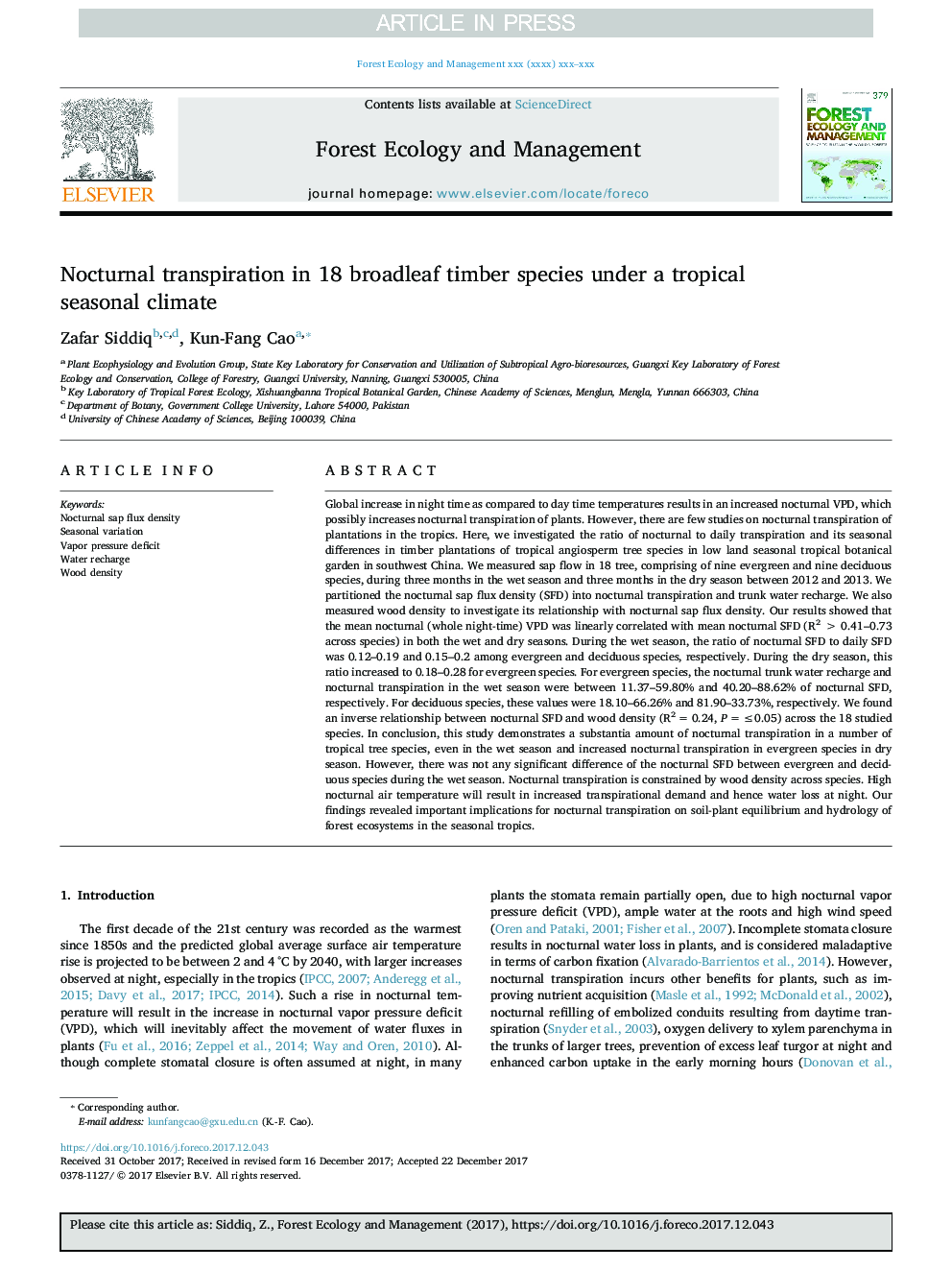| کد مقاله | کد نشریه | سال انتشار | مقاله انگلیسی | نسخه تمام متن |
|---|---|---|---|---|
| 6541730 | 1421341 | 2018 | 8 صفحه PDF | دانلود رایگان |
عنوان انگلیسی مقاله ISI
Nocturnal transpiration in 18 broadleaf timber species under a tropical seasonal climate
دانلود مقاله + سفارش ترجمه
دانلود مقاله ISI انگلیسی
رایگان برای ایرانیان
کلمات کلیدی
موضوعات مرتبط
علوم زیستی و بیوفناوری
علوم کشاورزی و بیولوژیک
بوم شناسی، تکامل، رفتار و سامانه شناسی
پیش نمایش صفحه اول مقاله

چکیده انگلیسی
Global increase in night time as compared to day time temperatures results in an increased nocturnal VPD, which possibly increases nocturnal transpiration of plants. However, there are few studies on nocturnal transpiration of plantations in the tropics. Here, we investigated the ratio of nocturnal to daily transpiration and its seasonal differences in timber plantations of tropical angiosperm tree species in low land seasonal tropical botanical garden in southwest China. We measured sap flow in 18 tree, comprising of nine evergreen and nine deciduous species, during three months in the wet season and three months in the dry season between 2012 and 2013. We partitioned the nocturnal sap flux density (SFD) into nocturnal transpiration and trunk water recharge. We also measured wood density to investigate its relationship with nocturnal sap flux density. Our results showed that the mean nocturnal (whole night-time) VPD was linearly correlated with mean nocturnal SFD (R2â¯>â¯0.41-0.73 across species) in both the wet and dry seasons. During the wet season, the ratio of nocturnal SFD to daily SFD was 0.12-0.19 and 0.15-0.2 among evergreen and deciduous species, respectively. During the dry season, this ratio increased to 0.18-0.28 for evergreen species. For evergreen species, the nocturnal trunk water recharge and nocturnal transpiration in the wet season were between 11.37-59.80% and 40.20-88.62% of nocturnal SFD, respectively. For deciduous species, these values were 18.10-66.26% and 81.90-33.73%, respectively. We found an inverse relationship between nocturnal SFD and wood density (R2â¯=â¯0.24, Pâ¯=â¯â¤0.05) across the 18 studied species. In conclusion, this study demonstrates a substantia amount of nocturnal transpiration in a number of tropical tree species, even in the wet season and increased nocturnal transpiration in evergreen species in dry season. However, there was not any significant difference of the nocturnal SFD between evergreen and deciduous species during the wet season. Nocturnal transpiration is constrained by wood density across species. High nocturnal air temperature will result in increased transpirational demand and hence water loss at night. Our findings revealed important implications for nocturnal transpiration on soil-plant equilibrium and hydrology of forest ecosystems in the seasonal tropics.
ناشر
Database: Elsevier - ScienceDirect (ساینس دایرکت)
Journal: Forest Ecology and Management - Volume 418, 1 June 2018, Pages 47-54
Journal: Forest Ecology and Management - Volume 418, 1 June 2018, Pages 47-54
نویسندگان
Zafar Siddiq, Kun-Fang Cao,